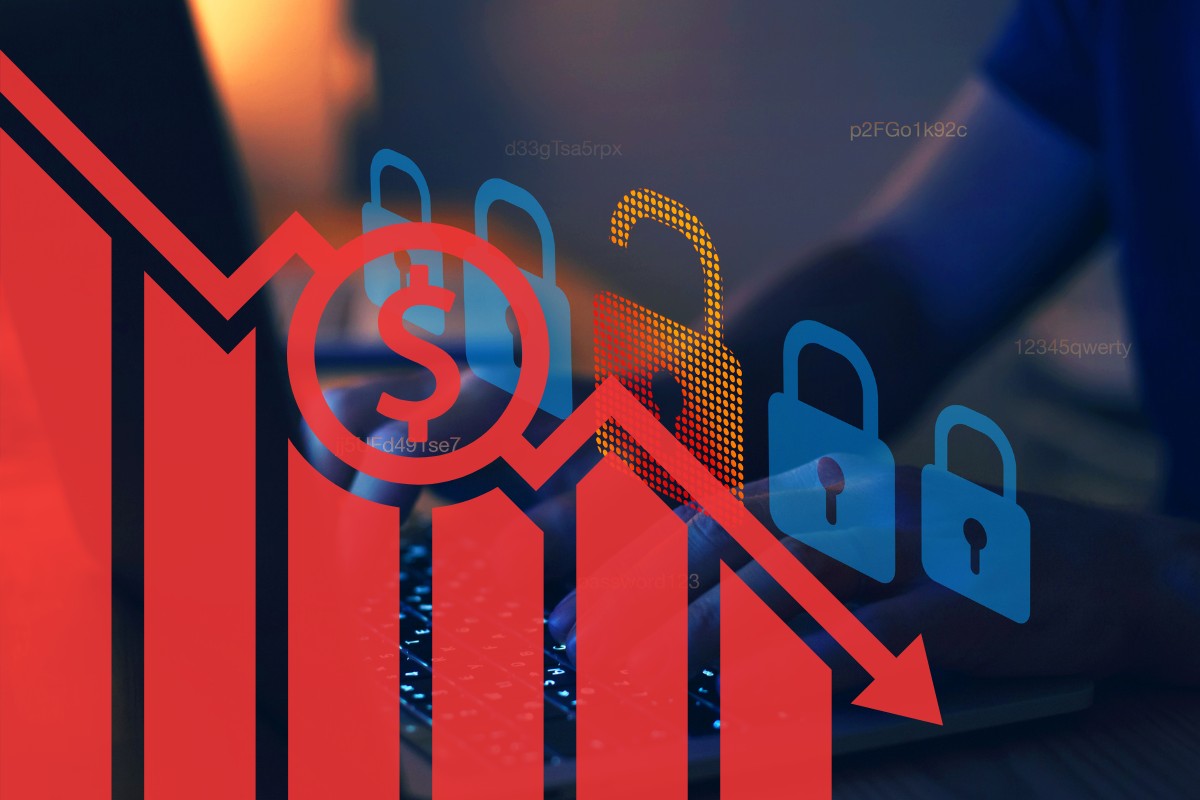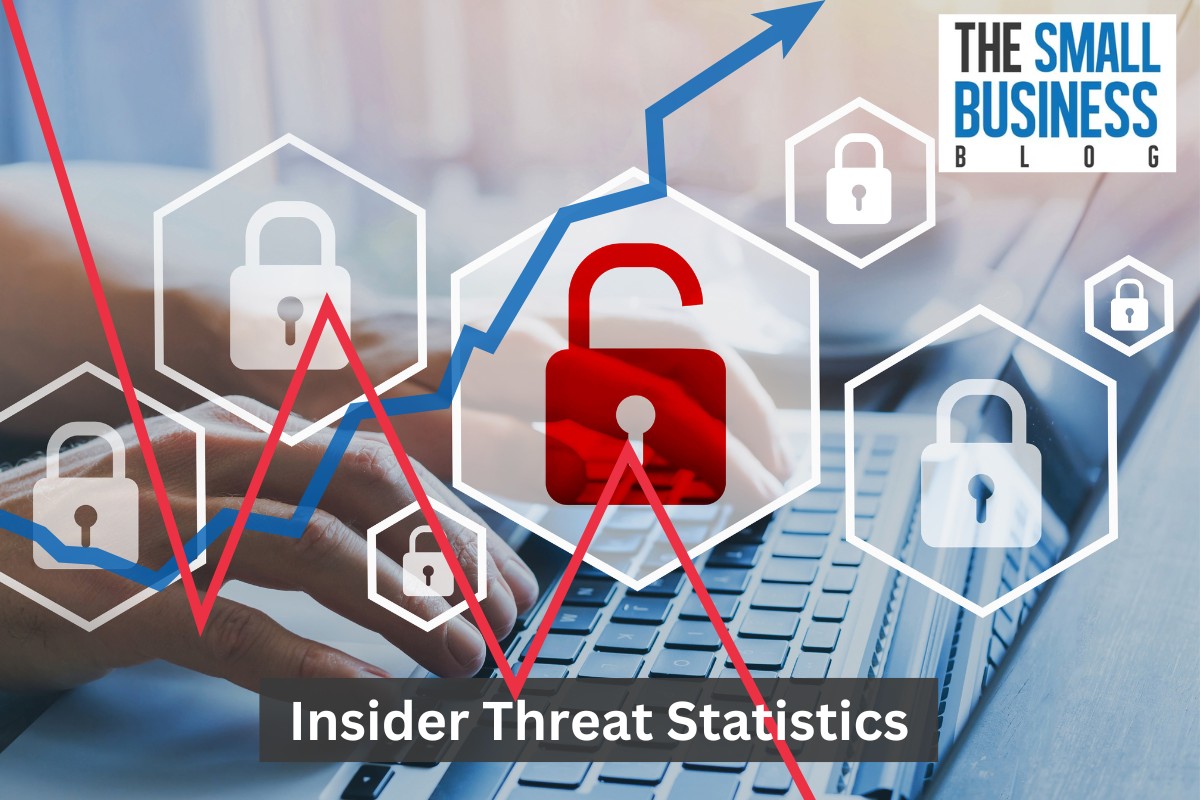In the world that we live in today, data breaches and cyberattacks have become all too common.
While external threats like hackers and viruses often take the spotlight, it’s important not to overlook the dangers posed by insiders.
Insider threats, a category of security risks involving individuals within an organization, continue to grow in both frequency and severity.
An insider threat occurs when a person with authorized access to an organization’s systems, data, or networks misuses their privileges for malicious purposes.
These individuals could be employees, contractors, or business partners who intentionally or unintentionally compromise security.
Insider threats can take various forms, including data theft, sabotage, fraud, and espionage.
In this article, we’ll explore the world of Insider Threat Statistics and explore the concerning data surrounding them.
Post Contents
- 1 Key Statistics
- 2 General Insider Threat Statistics in 2024
- 2.1 1. Insider attacks are a vulnerability for 68% of businesses
- 2.2 2. The primary insider security risk, according to 63% of organizations, is privileged IT users
- 2.3 3. Managers with access to sensitive data are identified as the leading insider threat actors by 60% of companies
- 2.4 4. Effective management of IT privileges is doubted by 78% of organizations
- 2.5 5. The primary motivation for insider attacks, at 55%, is fraud
- 2.6 6. Inadvertent data breaches are the top concern for businesses, with 71% expressing worry
- 2.7 7. Insider threats from personal devices used by employees are undetectable for 82% of organizations due to BYOD systems
- 2.8 8. Negligent employees or contractors account for 62% of insider incidents, ranking among the most common insider threats
- 2.9 9. For companies from North America, their expenditure for insider threats is at $13.3 million
- 2.10 10. Among accidental insider threats, phishing is considered the largest vulnerability by 38% of cybersecurity experts
- 3 Insider Threat Cost Statistics
- 3.1 11. Insider threats’ average annual cost surged by 31% in just two years, reaching $11.45 million
- 3.2 12. Determining the actual damage of an insider attack is considered difficult by 86% of organizations
- 3.3 13. 50% of organizations estimate the cost of a major security breach to be under $100,000
- 3.4 14. User behavior analytics (UBA) is the top tool and strategy that saved companies the most ($3.4 million)
- 3.5 15. Credential thefts cost companies $871,000 per occurrence
- 4 Insider Threat Prevention Statistics
- 4.1 16. Large organizations have invested $17.92 million in the past year for insider threat protection
- 4.2 17. Smaller companies averaged $7.68 million in insider threat protection expenditure
- 4.3 18. The financial services sector invested the most in measures against insider threats, totaling $14.50 million
- 4.4 19. A mere 42% of companies have implemented the necessary controls to prevent insider attacks
- 4.5 20. Detecting insider threats is deemed more challenging than identifying external attacks by 52% of businesses
- 4.6 21. Deterrence is the primary focus for more organizations (61%) when addressing insider threats
- 5 Conclusion
Key Statistics
- The most common type of insider threat in the US is data exfiltration (62%)
- 55% of the primary motivation of insider attacks is fraud
- Annually, the average cost of insider threats is at $11.45 million
- Only 42% of companies have the needed system to prevent an insider attack
- When countering insider threats, 61% of companies focus on deterrence
- 68% of businesses are vulnerable to insider attacks
General Insider Threat Statistics in 2024
1. Insider attacks are a vulnerability for 68% of businesses

Recent statistics reveal that a staggering 68% of businesses feel extremely vulnerable to moderately vulnerable to insider attacks.
The 68% vulnerability statistic explains the seriousness of the issue.
It signifies that a substantial majority of businesses acknowledge the potential threat posed by insiders.
One important factor to consider is that insider threats can be challenging to detect and prevent.
Unlike external threats, insiders already have legitimate access to an organization’s systems and data, making their activities less conspicuous.
Moreover, insiders often have a better understanding of the company’s defenses, which can help them evade detection.
(Cybersecurity Insiders)
2. The primary insider security risk, according to 63% of organizations, is privileged IT users
Recent statistics shed light on insider threats, revealing that 63% of organizations perceive privileged IT users as the most significant insider security risk they face.
The data highlights a growing concern within organizations: privileged IT users, who often hold significant access and control over an organization’s critical assets, are perceived as the most significant insider security risk.
Privileged IT users typically include system administrators, network engineers, and IT managers who require higher access rights to perform their duties effectively.
While these individuals are essential for maintaining an organization’s infrastructure, their high-level access can also become a security liability if misused or compromised.
(Cybersecurity Insiders)
3. Managers with access to sensitive data are identified as the leading insider threat actors by 60% of companies
Another striking revelation from insider threat statistics is that 60% of companies identify managers with access to sensitive information as the primary culprits.
These individuals, who often have a deeper understanding of a company’s operations, finances, and confidential data, can misuse their privileged positions for various reasons.
Whether it’s personal gain, revenge, or unintentional mishandling, managers represent a significant insider threat.
Following closely behind managers, contractors and consultants account for 57% of insider threat incidents.
This finding emphasizes the importance of proper monitoring of third-party personnel who often have temporary access to sensitive data.
While many of these individuals are trustworthy, the potential risks cannot be ignored.
(Bitglass)
4. Effective management of IT privileges is doubted by 78% of organizations
A recent study reveals a startling statistic: a staggering 78% of organizations do not believe they have very effective processes in place when managing IT privileges.
This finding sheds light on a critical vulnerability within organizations, one that often goes unnoticed until it’s too late.
IT privileges refer to the level of access and control employees have over an organization’s digital assets.
Effective privilege management is vital for preventing insider threats.
However, the aforementioned statistic, where 78% lack confidence in their IT privilege management processes, highlights a suspicious issue.
(Cybersecurity Insiders)
5. The primary motivation for insider attacks, at 55%, is fraud
One of the primary motivations behind insider attacks is fraud, accounting for 55% of all incidents.
In these cases, employees or trusted individuals misuse their access privileges to engage in fraudulent activities.
This may involve embezzlement, altering financial records, or other deceptive practices aimed at personal financial gain.
Another significant motivation behind insider threats is the pursuit of monetary gain, with 49% of incidents driven by this factor.
Employees with financial struggles or those tempted by financial incentives may resort to compromising sensitive data or engaging in unethical practices.
Lastly, protecting intellectual property (IP) is important for businesses in today’s competitive landscape.
Insider threats motivated by intellectual property theft make up 44% of all cases.
This category includes employees who may plan to use proprietary information for personal gain or sell it to external parties.
(Fortinet)
6. Inadvertent data breaches are the top concern for businesses, with 71% expressing worry

One of the most significant concerns for businesses is inadvertent data breaches, which account for 71% of their worries.
These breaches occur when employees accidentally expose sensitive data or compromise security protocols without malicious intent.
Such incidents may arise from simple human error, lack of awareness, or lack of training.
Closely behind inadvertent data breaches, 68% of businesses express concern over the negligence of employees when it comes to adhering to IT protocols.
Negligence includes ignoring or bypassing security measures, failing to update software promptly, or using weak passwords.
Such actions can unintentionally weaken an organization’s defense against both internal and external threats.
Malicious data breaches are another significant worry for businesses, with 61% citing this as a top concern.
These breaches involve employees intentionally compromising data security for personal gain, vendettas, or financial incentives.
(AT&T)
7. Insider threats from personal devices used by employees are undetectable for 82% of organizations due to BYOD systems
In today’s digital age, businesses are constantly adapting to new technologies and trends.
One such trend is the Bring Your Own Device (BYOD) system, which allows employees to use their personal devices for work purposes.
While BYOD offers convenience and flexibility, it also brings forth a concerning issue – insider threats.
The BYOD system has gained immense popularity in recent years.
It enables employees to use their personal smartphones, laptops, and tablets for work-related tasks, blurring the lines between personal and professional computing.
This trend is not without its advantages, as it can boost employee productivity and job satisfaction.
However, it has also opened a box full of security risks for organizations.
According to recent findings, 82% of organizations are unable to detect insider threats originating from personal devices used by their employees.
(Bitglass)
8. Negligent employees or contractors account for 62% of insider incidents, ranking among the most common insider threats
A startling fact is that a whopping 62% of insider incidents are due to negligent employees or contractors.
This statistic sheds light on the significance of negligence as a major contributor to insider threats.
Negligent insiders may inadvertently compromise data security through actions like sharing sensitive information inappropriately or falling prey to phishing attacks.
While negligent insiders take the most share of insider incidents, malicious insiders, who intentionally cause harm to their organizations, account for 14% of these incidents.
Though less common, the potential damage they can inflict is significant.
Malicious insiders may have motives ranging from financial gain to revenge, making them a particularly tricky challenge for organizations to detect and mitigate.
(Panda Security)
9. For companies from North America, their expenditure for insider threats is at $13.3 million
Nowadays, businesses across the globe face an ever-growing threat landscape, with insider threats emerging as a significant concern.
While external threats like cyberattacks remain prominent, insider threats are proving to be just as costly.
One staggering statistic that demands attention is the average annual cost of insider threats for North American companies, which stands at a whopping $13.3 million.
This figure is not to be taken lightly, as it represents a substantial financial blow to organizations.
Here is a list of the average annual cost of companies from all over the world:
- The average annual cost of insider threats for North American companies is at $13.3 million
- The average annual cost of insider threats for Middle Eastern companies is at $11.65 million
- The average annual cost of insider threats for European companies is at $9.82 million
- The average annual cost of insider threats for Asia-Pacific companies is at $7.89 million
(FinancesOnline)
10. Among accidental insider threats, phishing is considered the largest vulnerability by 38% of cybersecurity experts
Recent statistics reveal that cybersecurity experts consider phishing as a major vulnerability within the category of accidental insider threats.
In fact, a substantial 38% of these experts recognize phishing as the leading culprit in compromising an organization’s security.
The statistics speak for themselves: 38% of cybersecurity experts identify phishing as the topmost vulnerability within the area of accidental insider threats.
This statistic underscores the alarming prevalence of phishing attacks and highlights the extent to which organizations must focus on safeguarding against this threat.
(Fortinet)
Insider Threat Cost Statistics

11. Insider threats’ average annual cost surged by 31% in just two years, reaching $11.45 million
The latest statistics give a worrisome idea, with the average annual cost of insider threats skyrocketing by 31% in just two years, reaching a staggering $11.45 million.
In just two short years, the average annual cost of insider threats has seen an alarming 31% increase.
This surge has pushed the financial burden to an average of $11.45 million per year for affected organizations.
Such a substantial increase shows the growing complexity of reducing these threats.
(ObserveIT)
12. Determining the actual damage of an insider attack is considered difficult by 86% of organizations
Another key statistic highlights the difficulty organizations encounter when assessing the actual damage inflicted by insider attacks.
According to a recent survey among companies, a staggering 86% of organizations admit to finding it moderately difficult to determine the true extent of damage caused by these insider threats.
To address these challenges, organizations must adopt a unique approach to mitigate insider threats.
This includes regularly educating employees about security risks and best practices can help reduce the likelihood of insider threat and employing advanced monitoring and detection systems that can identify suspicious activities and behaviors within the organization.
(Cybersecurity Insiders)
13. 50% of organizations estimate the cost of a major security breach to be under $100,000
50% of surveyed organizations suggest that their estimate for a significant security breach falls below the $100,000 mark.
This seemingly small figure could be due to various factors, including the underestimation of hidden costs or a hesitation to acknowledge the true extent of the damage.
Notably, 34% of organizations anticipate damages to be in the range of $100,000 to $500,000.
This higher category reveals that a substantial portion of organizations acknowledges the potential financial impact of insider threats.
While it may not reach much higher figures than some fear, this range still represents a considerable expense for any organization.
(Cybersecurity Insiders)
14. User behavior analytics (UBA) is the top tool and strategy that saved companies the most ($3.4 million)
To reduce the financial and reputational damage caused by insider threats, organizations are adopting a range of tools and strategies.
Notably, user behavior analytics (UBA) emerges as a top choice, providing cost savings of approximately $3.4 million on average.
UBA uses machine learning algorithms to analyze user actions and identify suspicious behavior patterns, allowing for early threat detection.
Privileged access management (PAM) follows closely, with reported cost savings averaging $3.1 million.
PAM solutions grant granular control over who has access to sensitive systems and data, reducing the risk of insider misuse of privileged accounts.
User training and awareness programs are also proving effective, delivering savings of around $3 million.
These initiatives educate employees about the best security practices, encouraging them to recognize and report suspicious activities, ultimately strengthening an organization’s defense against insider threats.
(IBM)
15. Credential thefts cost companies $871,000 per occurrence
Some insiders go a step further by stealing the credentials of their colleagues, giving them access to sensitive data and systems.
These incidents are particularly costly, with an average cost of approximately $871,000 every time it happens.
The expenses associated with these breaches include not only the financial losses but also the extensive efforts required to regain control of compromised accounts and systems.
On another sinister side of the spectrum, criminal insiders intentionally exploit their position within an organization for personal gain.
Their actions can include theft, fraud, or sabotage.
The financial consequences of such incidents are a bit lower, averaging around $756,000 per occurrence.
In addition to financial losses, criminal insider threats can lead to legal action and severe damage to a company’s credibility.
Negligent insiders are individuals within a company who inadvertently cause security breaches through careless actions or ignorance.
The cost of such incidents is not to be underestimated, averaging approximately $307,000 each time.
(ObserveIT)
Insider Threat Prevention Statistics

16. Large organizations have invested $17.92 million in the past year for insider threat protection
Large organizations, those boasting more than 75,000 employees, find themselves in a unique position when it comes to insider threats.
Over the past year, these industry giants have invested an average of $17.92 million to protect themselves from insider threats.
This substantial allocation of resources highlights the scale of the issue and the significant financial commitment required to safeguard their assets.
Beyond size, the nature of the industry also plays a pivotal role in shaping a company’s approach to insider threats.
Some sectors are just more susceptible due to the nature of their work or the value of their data.
For instance, financial institutions, healthcare providers, and government agencies are among the industries that handle sensitive information and are, therefore, prime targets for insider threats.
Consequently, these sectors tend to allocate significant resources to counter this problem, regardless of their size.
(ObserveIT)
17. Smaller companies averaged $7.68 million in insider threat protection expenditure
On the flip side, smaller organizations with fewer than 500 employees follow a different path.
Their resources, though more limited, are dedicated to mitigating insider threats.
On average, they have allocated $7.68 million in the past year for this purpose.
While smaller organizations may not face the same magnitude of insider threats as their larger counterparts, they are not immune, and their investments reflect the importance of addressing this risk.
These are industries with lower inherent risks, with examples such as manufacturing or retail, and they may allocate smaller budgets for insider threat prevention.
This isn’t to say that they are immune to insider threats, but their priorities and investments differ based on their unique risk preferences.
(ObserveIT)
18. The financial services sector invested the most in measures against insider threats, totaling $14.50 million
Leading in the fight against insider threats is the financial services sector.
With an investment of $14.50 million, they are clearly committed to fortifying their defenses against these kinds of threats.
Given the highly sensitive nature of financial data and the potential for substantial financial losses, this dedication is understandable.
Financial institutions are employing advanced technologies and strict access controls to minimize the risk of insider threats.
Following closely behind is the services sector, which allocates $12.31 million to tackle insider threats.
This sector encompasses a wide range of industries, including healthcare, consulting, and hospitality.
Given the diverse nature of services offered, protecting sensitive client information and data is a top priority.
These organizations are investing significantly in training employees, implementing data loss prevention strategies, and monitoring user activities.
(IBM)
19. A mere 42% of companies have implemented the necessary controls to prevent insider attacks
Recent statistics reveal that only 42% of organizations have the necessary controls in place to prevent an insider attack, highlighting a critical vulnerability that requires immediate attention.
This statistic that only 42% of organizations have adequate controls to prevent insider attacks raises concerns.
This means that a significant portion of businesses is potentially susceptible to internal threats, putting sensitive data and assets at risk.
(AT&T)
20. Detecting insider threats is deemed more challenging than identifying external attacks by 52% of businesses
Recent statistics reveal that 52% of businesses acknowledge the difficulty in detecting insider threats compared to external attacks.
Detecting insider threats gives a unique set of challenges for organizations.
Unlike external attacks, where malicious actors attempt to breach an organization’s defenses from the outside, insiders already have legitimate access.
This complicates the identification process significantly.
(Cybersecurity Insiders)
21. Deterrence is the primary focus for more organizations (61%) when addressing insider threats

One of the standout statistics is that 61% of organizations are now prioritizing deterrence as a primary strategy against insider threats.
Deterrence involves creating a strong security culture within the organization, making potential insiders think twice before engaging in malicious activities.
This includes implementing strict security policies, conducting regular employee training, and promoting awareness of the consequences of insider threats.
Close behind deterrence, 60% of organizations are emphasizing the detection of internal threats.
Detecting insider threats in a timely manner is crucial for preventing them from causing substantial damage.
This often involves deploying advanced monitoring systems that can identify unusual behavior, unauthorized access, or data exfiltration.
By promptly detecting these anomalies, organizations can take swift action to mitigate the risk posed by insider threats.
(Cybersecurity Insiders)
Conclusion
In conclusion, insider threats are a real and pressing concern for organizations in our modern digital landscape.
The statistics we’ve explored here highlight the need for vigilance and proactive measures to combat these risks effectively.
As we rely more on digital systems and data, the potential consequences of insider threats become increasingly serious, not only in terms of financial losses but also damage to an organization’s reputation and customer trust.
To navigate this landscape safely, it’s essential for businesses to recognize the factors that contribute to insider threats. By doing so, they can take steps to prevent, detect, and respond to potential incidents.
Simple but effective strategies, such as controlling access, educating employees, and investing in monitoring tools, can go a long way in strengthening an organization’s security posture.
Nowadays, data is a valuable asset and breaches can have far-reaching consequences, safeguarding it from both external and internal threats should remain a top priority for all.
By staying informed and proactive, organizations can better protect themselves, ensuring a safer digital environment for everyone involved.
Sources
| Cybersecurity Insiders | Security Intelligence | AT&T Cybersecurity |
| Forcepoint | IBM | Securinox |
| Fortinet | FinancesOnline | Panda Security |






























